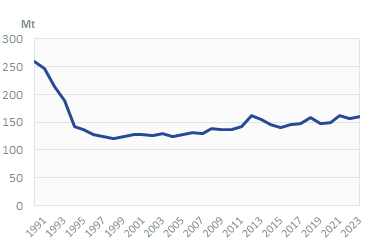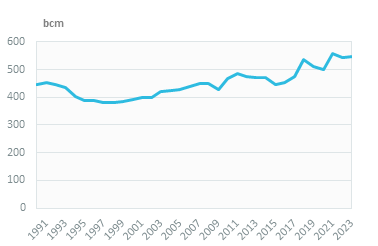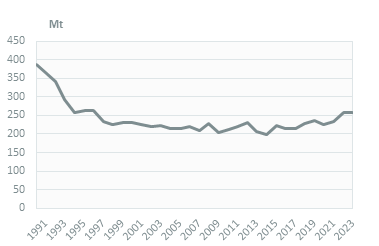-
-
 Energy and Climate Databases
Energy and Climate Databases- The most comprehensive and up-to-date annual energy database.
- Monitoring of technology providers in H2 supply chain.
- Monthly energy data on key energy markets.
- The most reliable and up-to-date power generation database.
- The essentials of LNG trade at your fingertips.
- Global monitoring of new and existing refineries.
- Analyse energy consumption and efficiency trends at world level. Benchmark countries.
- Have your database developed by a recognised expert of both energy and IT.
-
 Energy - Climate Forecasts
Energy - Climate Forecasts- Instant access to energy and emissions forecasts.
- Strategic, annual wholesale price projections backed by Enerdata's energy modelling expertise and our globally recognised POLES model.
- Wedges module showing a breakdown of the levers enabling to reduce emissions between two scenarios.
- Unique, independent projections of consumption by end-use.
- GHG Marginal Abatement Cost Curves.
- Benefit from proven models to draw your own energy scenarios and anticipate tomorrow’s challenges.
-
 Market Intelligence
Market Intelligence- 110 Energy and climate country reports
- A newsletter to receive the latest updates on evolving technologies and policies.
- Global energy news and analyses curated daily.
- Enerdata’s experts bring you the essentials about your market and competitors.
-
-
-
 Market Analysis
Market Analysis- Understanding key consumption trends and drivers across sectors.
- Granular and exclusive insight to address the most pressing business and strategic issues.
- Expertise in strategic and business intelligence, with fine-tuning to the market’s specificities.
-
 Energy - Climate Scenarios
Energy - Climate Scenarios- Providing the outlook of an energy commodity in mid to long term time horizons.
- Sector and driver specific energy demand forecasting.
- Assess the evolution of energy prices on the international and regional markets, as well as end-users prices.
- Enerdata guides you through pathways to reach climate targets.
- Supporting local authorities in their decarbonisation strategies.
-
 Climate Strategy and Policy Evaluation
Climate Strategy and Policy Evaluation- Cutting-edge quantitative tools and relevant indicators to monitor and evaluate evolutions on worldwide energy markets.
- Analysis of the most cost-effective options to reduce emissions.
- Quantified simulation and analysis of pledges for climate change negotiations.
- Breakdown and analysis of carbon markets.
- Enerdata guides you on the most beneficial policy or investment options.
- Turning climate objectives into concrete action plans.
-
 Training
Training- Understand different policy targets and measures on energy efficiency.
- How to measure energy savings?
- Energy Forecasting is a 2 days training to learn to design and interpret energy forecasts.
- Energy statistics training allowing to create energy balance with supply, transformation and consumption and understanding the international energy statistics regulations.
- Initiation to EnerMED level 1is the training to approach on the most powerful energy demand forecasting model.
-
-
Resource Centre
Russia Key Figures
- Population:
- 143 million
- GDP growth rate:
- 3.59 %/year
- Energy independence:
- 100%
Data of the last year available: 2023
- Total consumption/GDP:*
- 89.7 (2005=100)
- CO2 Emissions:
- 13.7 tCO2/capita
- Rate of T&D power losses:
- 8.75%
* at purchasing power parity
View all macro and energy indicators in the Russia energy report
Russia Related News
View all news, archive your new and create your own daily newsletters only on your topics/countries of interest with Key Energy Intelligence
Russia Related Research
Benefit from up to 2 000 up-to-date data series for 186 countries in Global Energy & CO2 data
A data overview is available in the global energy statistics app
Total Energy Consumption
Total per capita consumption reached 6 toe in 2023. Per capita electricity consumption was around 6 961 kWh.
Total energy consumption increased by 2% in 2023 to 853 Mtoe, after a slight decrease in 2022 (-1.2%). Previously, it increased rapidly between 2015 and 2019 (2.8%/year) before dropping by 4% in 2020 and rebounding by 9% in 2021.
In 2023, gas represented the largest share of consumption (54%), followed by oil (19%), coal (17%), nuclear (7%), hydro (2%), and biomass (1%).
Graph: CONSUMPTION TRENDS BY ENERGY SOURCE (Mtoe)
Interactive Chart Russia Total Energy Consumption
Benefit from up to 2 000 up-to-date data series for 186 countries in Global Energy & CO2 data
View the detailed fondamentals of the market at country level (graphs, tables, analysis) in the Russia energy report
Crude Oil Production
Crude oil production fell by 1.5% in 2023 to 535 Mt, after an increase of 2%/year over 2020-2022. Prior to that it had increased by 1.3%/year between 2014 and 2019 and dropped by around 8% in 2020. Russia is the world's second largest crude oil producer, after the USA, at the same level as Saudi Arabia.
Russia will cut oil production by 500 kb/d (-5%) until end 2023, as part of the OPEC+ reduction of 1.16 mb/d in April 2023. Russia announced it would pursue its voluntary cuts of 0.5 mb/d until December 2024, with an additional 0.47 mb/d cut until July 2024.
Interactive Chart Russia Crude Oil Production
Benefit from up to 2 000 up-to-date data series for 186 countries in Global Energy & CO2 data
Additionally, for more detailed information on refineries, you can request a sample of our EMEA Refineries Dataset
Oil Products Consumption
Oil consumption increased by about 2% in 2023 to 160 Mt, after a 2.5% decrease in 2022. It had previously rebounded by 5% in 2021 after dropping by around 4% in 2020. It remained roughly stable between 2012 and 2019 at about 150 Mtoe.
Graph: OIL CONSUMPTION (Mt)

Interactive Chart Russia Refined Oil Products Production
Benefit from up to 2 000 up-to-date data series for 186 countries in Global Energy & CO2 data
Additionally, for more detailed information on refineries, you can request a sample of our EMEA Refineries Dataset
Natural Gas Consumption
Gas consumption increased by 4% in 2023, reaching 564 bcm, after a 3% decrease in 2022. In 2021, it rebounded by 12% after dropping by 2% in 2020. It grew by around 5%/year between 2016 and 2019.
Gas is mainly consumed in the electricity sector (38%). Industry represents 18% and the residential-services sector 17%.
Graph: NATURAL GAS CONSUMPTION (bcm)

Graph: GAS CONSUMPTION BREAKDOWN BY SECTOR (2023, %)
Interactive Chart Russia Natural Gas Domestic Consumption
Benefit from up to 2 000 up-to-date data series for 186 countries in Global Energy & CO2 data
Additionally, for more detailed information on the LNG trade, you can request a sample of our EMEA LNG Trade Dataset
Coal Consumption
Coal and lignite consumption has increased by 4.7%/year since 2020, reaching 258 Mt in 2023. It increased by 3.4%/year between 2014 and 2019 and dropped by almost 11% in 2020.
More than half of the coal and lignite is consumed in power plants (54% in 2023) and 18% is used in industry.
Graph: COAL CONSUMPTION (Mt)

Graph: COAL CONSUMPTION BREAKDOWN BY SECTOR (2023, %)
Interactive Chart Russia Coal and Lignite Domestic Consumption
Benefit from up to 2 000 up-to-date data series for 186 countries in Global Energy & CO2 data
View the detailed consumption trends at country level (graphs, tables, analysis) in the Russia energy report
Power Consumption
Total electricity consumption has increased by 2.9%/year since 2020 (including a 5% spike in 2021), reaching 997 TWh in 2023. It increased slightly between 2010 and 2019 (1%/year).
Industry is the main electricity consumer with 37% of the total (-8 points since 2000), ahead of the residential sector with 18% (20% in 2000) and services with 18% also (nearly doubling since 2000). Transport accounts for 6% of total electricity consumption, i.e. a significant share compared to other countries, due to the strong presence of public transport.
Graph: ELECTRICITY CONSUMPTION (TWh)
Renewable in % Electricity Production
The Government target for 2020 of a 2.5% share of wind and solar in the power mix (State Programme on Energy Efficiency and Energy Development, 2014) was not reached (0.3% in 2020). In 2021, the authorities announced plans to award RUB 360bn (US$4.9bn) of state support for renewable projects through 2035, with the aim of adding 12 GW of renewables by 2035. In 2021, the Ministry of Energy announced that it will seek to increase the share of renewables to 31.5% of the power mix by 2050 (of which 19% from hydropower, and 12.5% from wind and solar).
Interactive Chart Russia Share of Renewables in Electricity Production (incl hydro)
Benefit from up to 2 000 up-to-date data series for 186 countries in Global Energy & CO2 data
CO2 Fuel Combustion/CO2 Emissions
Inits first NDC (2020), the country set the target to cut GHG emissions to 70% of their 1990 level in 2030 to 2.2 GtCO2eq, taking into account the maximum possible absorptive capacity of forests. In 2022, GHG emissions were 16% below their 1990 level according to EDGAR estimates at 2.58 GtCO2eq, which represents half of the NDC objective.